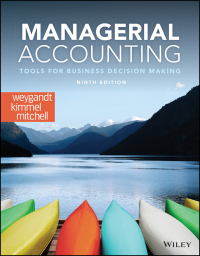Question
.Process Costing (Weighted-Average Method) - 16pts: Partners in Crime Paint Company uses the weighted-average method to account for costs of production in its process costing
.Process Costing (Weighted-Average Method) - 16pts:Partners in Crime Paint Company uses the weighted-average method to account for costs of production in its process costing system. Partners in Crime manufactures its base paint in two separate departments:Mixing and Packaging.The following information is for the Mixing Department (the first production department in its production process) for the month of March:
Units (gallons)
Percent Complete with
Respect to DM
Percent Complete with
Respect to Conversion Costs (DL+OH)
Beginning work in process inventory
69,500
100%
40%
Units started during March
391,700
Units completed and transferred to the Packaging Department during March
407,600
100%
100%
Ending work in process inventory
53,600
75%
55%
The accounting records for the Mixing Department indicate the following additional information:
Costs in beginning WIP Inventory-Mixing Department totaled $191,125, broken down as follows:
o$139,000 in DM costs
o$52,125 in conversion costs
Costs incurred during the month of March for the Mixing Department totaled $1,135,930, broken down as follows:
o$822,570 in actual DM costs
o$313,360 in conversion costs ($125,344 in DL costs; $188,016 in applied OH costs (applied based on 150% of DL costs))
PART A (4pts) - Calculations for the Mixing Department (use the Weighted-Average Method):
1.Calculate the equivalent units of production for March for DM and Conversion Costs (DL+OH).
2.Calculate the cost per equivalent unit of production (EUP) for DM and for Conversion Costs for March (round cost per EUP to the nearest cent, i.e. to two decimal places).
3.Using the costs per equivalent unit calculated in PART A, 2.:
a.Assign costs to the completed units transferred out of the Mixing Department to the Packaging Department
b.Assign costs to the units remaining in ending WIP Inventory - Mixing Department
PART B (8pts) - Journal Entries:Prepare journal entries for the month of March to record the below transactions (make sure to use proper journal entry formatting and include a brief description of each entry).
1.Raw materials purchases: Assume the firm purchased $902,000 worth of raw materials on account in March.
2.Direct materials used in production:Mixing Department: $822,570;Packaging Department: $71,910.
3.Direct labor used in production (use the Factory Wages Payable account for the credit):Mixing Department: $125,344;Packaging Department: $19,670.
4.Overhead costs applied:Mixing Department: $188,016;Packaging Department:$29,505.
5.Transfer of costs of units transferred out from the Mixing Department to the Packaging Department (amount calculated in A.3.a. above).
6.Transfer of costs of completed units transferred out from the Packaging Department to Finished Goods Inventory.Assume the costs of these finished goods transferred out from the Packaging Department to Finished Goods Inventory during March was $1,350,927.
7.Transfer of costs from Finished Goods Inventory to COGS.Assume the costs of the units sold transferred from Finished Goods to COGS was $1,298,621.
8.Assignment of any underapplied or overapplied overhead to the Cost of Goods Sold account (Assume the amount is not material).Assume that actual Indirect materials used = $19,501, actual Indirect labor used = $38,707, and actual other overhead costs incurred = $159,340.
PART C (4pts) - Balance Sheet accounts, ending balances:Using all of the information given above, determine the March 31st ending balances of each the firm's inventory accounts listed below.You must show all of your work, either using formulas/calculations or T-accounts.
1)Raw Materials Inventory account (Assume the beginning balance of the raw materials inventory account as of March 1st was $97,415).
2)WIP Inventory - Mixing (Assume the beginning balance of WIP-Mixing is $191,125, as given in the information above).
3)WIP Inventory - Packaging (Assume the beginning balance of WIP-Packaging is $223,009).
4)Finished Goods Inventory (Assume the Finished Goods Inventory balance as of March 1st was $95,813).
Step by Step Solution
There are 3 Steps involved in it
Step: 1

Get Instant Access to Expert-Tailored Solutions
See step-by-step solutions with expert insights and AI powered tools for academic success
Step: 2

Step: 3

Ace Your Homework with AI
Get the answers you need in no time with our AI-driven, step-by-step assistance
Get Started


